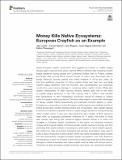Por favor, use este identificador para citar o enlazar a este item:
http://hdl.handle.net/10261/260306COMPARTIR / EXPORTAR:
 SHARE SHARE
 CORE
BASE CORE
BASE
|
|
| Visualizar otros formatos: MARC | Dublin Core | RDF | ORE | MODS | METS | DIDL | DATACITE | |

| Título: | Money Kills Native Ecosystems: European Crayfish as an Example |
Autor: | Jussila, Japo; Edsman, Lennart; Maguire, Ivana; Dieguez-Uribeondo, Javier CSIC ORCID ; Theissinger, Kathrin | Palabras clave: | conservation biased decision making environmental economics political ecology fisheries administration native and alien crayfish shortsightedness |
Fecha de publicación: | 2021 | Editor: | Frontiers Media | Citación: | Frontiers in ECOLOGY AND EVOLUTION 9 (2021) | Resumen: | Native European crayfish conservation was triggered by invasion of crayfish plague disease agent, Aphanomyces astaci, starting 1860s in Northern Italy. Resulting crayfish plague epidemics quickly spread over Continental Europe, then to Finland, Sweden and finally, after running amok around Europe, A. astaci was discovered also in Iberian Peninsula, Norway, Ireland, and United Kingdom in 1970s and 1980s. By that time significant proportion of native crayfish stocks had been lost, and while crayfish plague epidemics were still recorded, also industrialization and waterways construction were causing damage to remaining native crayfish stocks. While alien crayfish introductions, at least Faxonius limosus, already gave rise to first wave of crayfish plague epidemics in late 19th century, later in 1960s it was decided that introductions of alien Pacifastacus leniusculus should be initiated to replace native European crayfish populations. Decisions were based on presumed advantages for fishery, suitable habitat requirements and supposed immunity against A. astaci. Furthermore, conservation of native European crayfish species was sidelined and focus shifted toward alien crayfish stocking routine and consumption. Alien crayfish species introductions resulted in repeated waves of crayfish plague epidemics among remaining native crayfish stocks. It was soon discovered that alien crayfish of North American origin were, as suspected, permanent reservoirs for A. astaci, that some of those alien species were losing their resistance against selected strains of A. astaci and struggled in European aquatic ecosystems. In this article, we introduce numerous motives behind grand mistake of introducing alien crayfish species to Europe and then promoting their stocks instead of focusing on conservation of native crayfish species. We outline how false economical, biological and ecologic assumptions were used to justify a hasty introduction of alien crayfish, which has further devastated native crayfish and also permanently changed European aquatic ecosystems, both with disastrous consequences. Lesson to be learnt is that science-based warnings about alien species damage to native ecosystems and native crayfish must be taken with utmost caution. Protection of native European crayfish should be core issue, not commercial activities. Finally, we summarize main threats and actions needed to protect remaining native freshwater crayfish fauna in Europe. | Versión del editor: | http://dx.doi.org/10.3389/fevo.2021.648495 | URI: | http://hdl.handle.net/10261/260306 | DOI: | 10.3389/fevo.2021.648495 | Identificadores: | doi: 10.3389/fevo.2021.648495 issn: 2296-701X |
| Aparece en las colecciones: | (RJB) Artículos |
Ficheros en este ítem:
| Fichero | Descripción | Tamaño | Formato | |
|---|---|---|---|---|
| fevo-09-648495.pdf | 616,22 kB | Adobe PDF |  Visualizar/Abrir |
CORE Recommender
SCOPUSTM
Citations
36
checked on 25-abr-2024
WEB OF SCIENCETM
Citations
32
checked on 29-feb-2024
Page view(s)
25
checked on 02-may-2024
Download(s)
61
checked on 02-may-2024
Google ScholarTM
Check
Altmetric
Altmetric
Este item está licenciado bajo una Licencia Creative Commons

